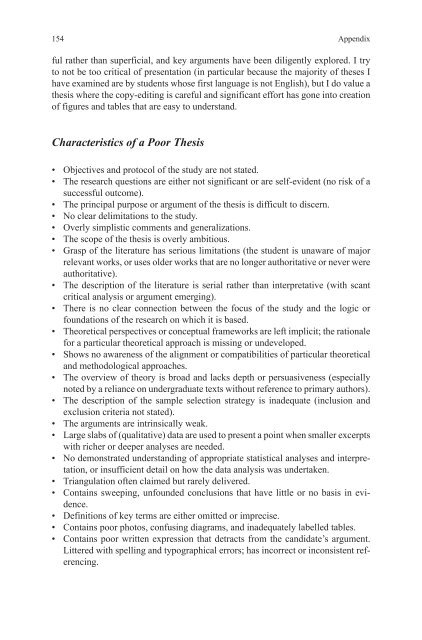How-to-Write-a-Better-Thesis
You also want an ePaper? Increase the reach of your titles
YUMPU automatically turns print PDFs into web optimized ePapers that Google loves.
154 Appendix<br />
ful rather than superficial, and key arguments have been diligently explored. I try<br />
<strong>to</strong> not be <strong>to</strong>o critical of presentation (in particular because the majority of theses I<br />
have examined are by students whose first language is not English), but I do value a<br />
thesis where the copy-editing is careful and significant effort has gone in<strong>to</strong> creation<br />
of figures and tables that are easy <strong>to</strong> understand.<br />
Characteristics of a Poor <strong>Thesis</strong><br />
• Objectives and pro<strong>to</strong>col of the study are not stated.<br />
• The research questions are either not significant or are self-evident (no risk of a<br />
successful outcome).<br />
• The principal purpose or argument of the thesis is difficult <strong>to</strong> discern.<br />
• No clear delimitations <strong>to</strong> the study.<br />
• Overly simplistic comments and generalizations.<br />
• The scope of the thesis is overly ambitious.<br />
• Grasp of the literature has serious limitations (the student is unaware of major<br />
relevant works, or uses older works that are no longer authoritative or never were<br />
authoritative).<br />
• The description of the literature is serial rather than interpretative (with scant<br />
critical analysis or argument emerging).<br />
• There is no clear connection between the focus of the study and the logic or<br />
foundations of the research on which it is based.<br />
• Theoretical perspectives or conceptual frameworks are left implicit; the rationale<br />
for a particular theoretical approach is missing or undeveloped.<br />
• Shows no awareness of the alignment or compatibilities of particular theoretical<br />
and methodological approaches.<br />
• The overview of theory is broad and lacks depth or persuasiveness (especially<br />
noted by a reliance on undergraduate texts without reference <strong>to</strong> primary authors).<br />
• The description of the sample selection strategy is inadequate (inclusion and<br />
exclusion criteria not stated).<br />
• The arguments are intrinsically weak.<br />
• Large slabs of (qualitative) data are used <strong>to</strong> present a point when smaller excerpts<br />
with richer or deeper analyses are needed.<br />
• No demonstrated understanding of appropriate statistical analyses and interpretation,<br />
or insufficient detail on how the data analysis was undertaken.<br />
• Triangulation often claimed but rarely delivered.<br />
• Contains sweeping, unfounded conclusions that have little or no basis in evidence.<br />
• Definitions of key terms are either omitted or imprecise.<br />
• Contains poor pho<strong>to</strong>s, confusing diagrams, and inadequately labelled tables.<br />
• Contains poor written expression that detracts from the candidate’s argument.<br />
Littered with spelling and typographical errors; has incorrect or inconsistent referencing.














![[Lonely Planet] Sri Lanka](https://img.yumpu.com/59845622/1/169x260/lonely-planet-sri-lanka.jpg?quality=85)


